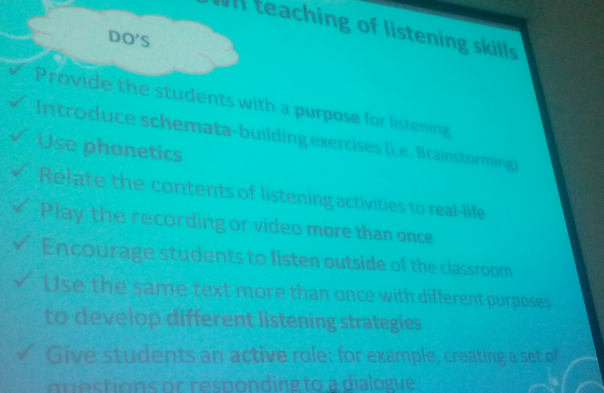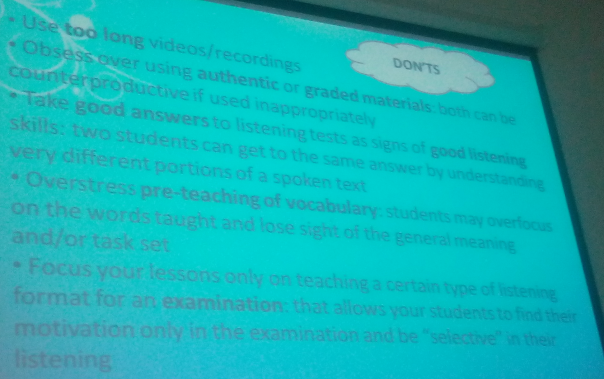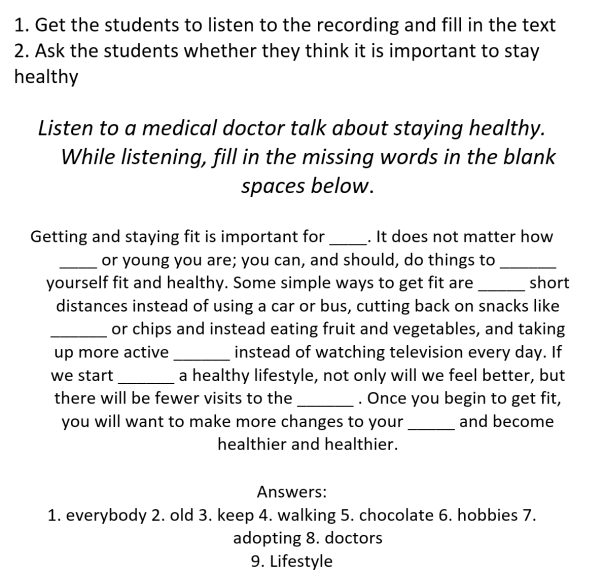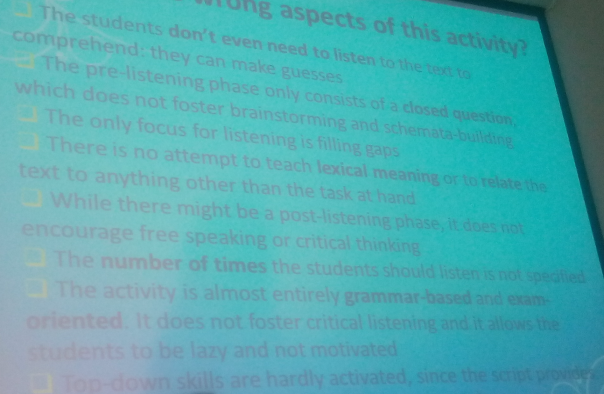This is the second summary from the TESOL Italy 2016 talks that I saw. The first one was Henry Widdowson’s plenary ‘ELF and TESOL: a change of subject?’, and you can read it here.
Chiara’s talk starts off with a short video. Two people are having breakfast and chatting away. A third one arrives and joins the chat.
The language sounds vaguely familiar, but doesn’t seem to be making much sense. In fact, Chiara tells us after we’ve watched it that it’s made up of different lines from different song lyrics jumbled together.
And this is exactly how English might sound to our students’ ears. Difficult to understand. Confusing. The likely outcome is that they’ll feel frustrated. And perhaps this is one of the reasons why teaching listening is important. But not the only one, of course. Some other that Chiara lists are:
- Low English proficiency of students in Italy
- English is becoming more and more important in everyday life
- It’s the Cinderella skill
- Students’ perceptions need to be taken into account for curriculum development
- Most of the time listening is tested rather than taught in class
The two most common theories which inform how we teach listening are bottom-up and top-down processing. However, rather than choosing between one or the other, it is important we adopt a more integrated approach; that is, helping our learners develop and use both top-down and bottom-up skills.
The rest of the talk is informed by a research Chiara carried out. The sample was made up of 121 Italian students of English aged 16 to 19 and 5 Italian English teachers. To gather data she used questionnaires, interviews with teachers and classroom observations.
The research focused on the appreciation of students for listening activities, the materials and sources used in the classroom, the importance of the skill and the students’ difficulties.
The two main findings that Chiara drew on to provide her practical suggestions were a general good level of appreciation of the students for listening skills and the problems that they highlighted. Most of them referred to perception and parsing problems as being prominent, and their teachers seemed to show a good level of awareness regarding this.
So, it seems that in this particular study students are motivated, enjoy listening and see it as important. The question is then, how can we capitalise on these positive perceptions to improve students’ listening?
First, we should stop just testing listening, and focus on teaching it. I wrote more about this in this post.
As far as bottom-up skills go, we can for example focus on connected speech, weak forms or variations in pronunciation of individual sounds.
Some ways in which we can attempt to help students improve top down skills are:
- Inferring missing information
- Continue listening despite difficulties
- Predicting unfinished utterances.
- Taking notes of content words.
- Paying attention to discourse markers, visuals, body language.
In the next part of the talk we were provided with a very useful list of listening Dos and Don’ts.
DOs
DON’Ts
Then, we had to put them into practice to assess the listening activity you can see below. What do you think is wrong with it and how could it be improved?
Some things that were wrong with it can be seen on this slide:
Finally, there are several ways in which we can try to make our listening lessons more interesting, and more focused on teaching rather than testing listening, which Chiara called listening with a twist:
- Use a wordcloud as a prelistening: www.worditout.com
- Students watch part of a TV series as an extensive listening and imagine how they would have acted in the situations shown
- Instead of questions, students can be given a drawing, a map or a table to fill
- Play chunks of language and ask students to identify how many words they can hear, and then which words
- Let the students choose their favourite songs or video clips to listen to in class
You can find more tips for teaching listening in some of the previous posts from this blog as well as in the listening section here:
- Let’s bring back the TAPES
- Teaching listening: tweaking the CELTA approach
- Planning a listening lesson: 15 tips
- Teaching listening: example lesson plan and reflection
- The real deal – authentic materials or authentic tasks?
Chiara is an English teacher and translator based in Milan. She has taught English as a second language in England, Spain and Italy. She has a BA in Interpreting and Translation (University of Bologna) and an MA in TESOL and Translation Studies (Aston University, Birmingham). Her main interests in the TESOL field are pronunciation, comparative grammar, the teaching of listening skills and communicative language teaching applied to business contexts.





could you give me the instrument of your research